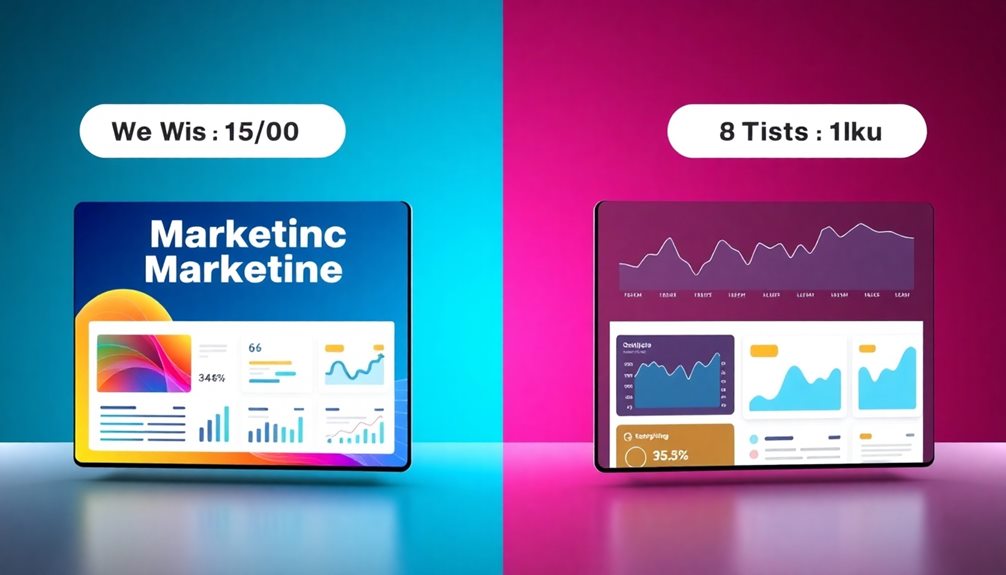To start a niche blog and monetize it, first, choose a profitable niche that aligns with your interests. Research your audience to understand their needs and preferences. Set up your blog on a self-hosted platform like WordPress and create engaging, high-quality content that resonates with your readers. Optimize your posts for SEO to attract traffic and promote your blog through social media. Build an email list to nurture your audience. Finally, explore monetization options like affiliate marketing, ads, or selling digital products. Keep refining your strategy, and you'll find effective methods to boost your income. Ready to explore further?
Key Takeaways
- Choose a profitable niche by conducting market research to understand audience demand and competition.
- Set up your blog on a self-hosted platform like WordPress, ensuring a memorable domain and reliable hosting.
- Create high-quality, engaging content tailored to your audience's needs while incorporating SEO best practices for visibility.
- Build an email list early on and utilize email marketing techniques to engage your audience and promote monetization strategies.
- Explore various monetization options such as affiliate marketing, sponsored posts, and selling digital products to generate income.
Choosing Your Niche

Choosing your niche is one of the most vital steps in starting a niche blog, as it sets the foundation for your content and audience engagement.
To maximize monetization potential, consider niches like personal finance or health, where affiliate marketing thrives. Understanding key concepts such as common financial terms can also enhance your content's value.
Begin with thorough market research to understand your audience's demographics and pain points. This insight helps you create targeted content that resonates with readers.
Avoid overly specific niches that might limit your reach. Instead, focus on a specialized area with enough demand to attract a sustainable readership.
Analyzing the competition within your chosen niche is essential. Identify their strengths and weaknesses to carve out your unique angle for content creation.
Understanding Your Audience

Once you've settled on a niche, the next step is getting to know your audience inside and out. Understanding your audience is essential for creating targeted content that resonates. Start by analyzing demographics like age, gender, income level, and interests to tailor your blog effectively.
| Demographic | Importance | Action Item |
|---|---|---|
| Age | Determines content style | Create age-appropriate topics |
| Gender | Influences interests | Use gender-specific language |
| Income Level | Affects spending habits | Suggest relevant products |
| Interests | Guides content preferences | Focus on trending topics |
Utilize tools like Google Analytics to identify pain points and engagement metrics. Engaging with your audience through comments and social media offers valuable insights. Consider conducting surveys or polls to gather specific information about their content preferences. Additionally, monitoring competitors in your blog niche can reveal gaps in their strategies, allowing you to address unmet needs in your target audience.
Setting Up Your Blog

Setting up your blog is a crucial step that lays the foundation for your online presence. To maximize control and flexibility, choose a self-hosted platform like WordPress.org. Free platforms may limit your growth and monetization options.
Here's how to get started:
- Select a memorable domain name: Aim for something brandable and ideally with a .com extension.
- Invest in a reliable web hosting provider: Consider options like Bluehost for speed, security, and excellent customer support.
- Design your blog: Opt for a clean, mobile-friendly theme that enhances user experience across devices. Including niche topics, such as essential oils for toothache relief, can attract specific audiences and provide them with valuable content.
Once your blog is set up, develop a content strategy to outline your target topics and publishing frequency.
Conduct thorough keyword research to attract and engage your audience effectively. This planning won't only help you create valuable content but also position your blog for future growth.
Crafting Quality Content

When it comes to crafting quality content, focusing on your audience's needs is essential. By creating informative and engaging blog posts that address their pain points, you'll build reader trust and retention. Incorporating relevant keywords naturally enhances your SEO practices, making your content more discoverable.
Additionally, consider using multimedia elements like images and videos. Research shows articles with visuals receive 94% more views, boosting audience engagement. Establishing a consistent publishing schedule is vital; 82% of marketers agree that regular posting improves visibility and trust.
To illustrate the key elements of crafting quality content, here's a simple table:
| Element | Importance | Tips |
|---|---|---|
| Audience Needs | Builds trust and retention | Research your target audience |
| Relevant Keywords | Improves SEO | Use in titles and headings |
| Multimedia Elements | Increases engagement | Include images and videos |
In essence, prioritize high-quality content that focuses on depth over quantity. A well-researched post can far outperform several mediocre ones, making it easier to monetize your niche for your blog effectively.
SEO Best Practices

When it comes to boosting your niche blog's visibility, mastering keyword selection techniques is key.
To effectively attract your target audience, it's beneficial to explore advanced digital marketing strategies that can enhance your content's reach.
You'll want to focus on effective on-page optimization strategies to enhance your content's performance.
Plus, keeping your content fresh not only engages your readers but also helps improve your search engine rankings.
Keyword Selection Techniques
Effective keyword selection is essential for the success of your niche blog, as it helps attract the right audience and boosts your visibility in search engine results. High-quality content that effectively utilizes keywords can enhance credibility and engage users, ultimately improving retention and reducing bounce rates.
Start with thorough keyword research to identify low-competition keywords that drive targeted traffic. Focus on long-tail keywords, as they often reflect specific user intent and face less competition than high-volume keywords. Additionally, maintaining a consistent update schedule for your keywords can signal relevance to search engines, further enhancing your blog's visibility importance of content quality.
Here are some techniques to enhance your keyword selection process:
- Use tools like Google Keyword Planner and Ahrefs to analyze keyword difficulty and search volume.
- Naturally incorporate relevant keywords into your blog titles, headings, and content to improve rankings without keyword stuffing.
- Regularly update your content with new keywords to keep it fresh and relevant.
On-Page Optimization Strategies
To boost your blog's visibility and engagement, you need to nail down on-page optimization strategies that enhance your SEO. Start by incorporating relevant keywords naturally in your titles, headings, and throughout your content. This practice improves search engine ranking and helps your blog name stand out.
When you upload images, use descriptive alt text to enhance SEO and provide context for search engines, improving accessibility. Additionally, content quality and topical authority play an essential role in establishing your blog's credibility.
Next, optimize your meta descriptions with compelling and keyword-rich summaries. This tactic can markedly increase your click-through rates from search engine results pages.
Additionally, implement internal linking strategies to guide your visitors to related content, which enhances user experience and keeps them on your site longer.
Creating quality content is vital, but don't forget to regularly update it to keep it fresh and relevant. This signals to search engines that your website goes the extra mile to provide valuable information.
Content Freshness Importance
Keeping your blog content new is essential for maintaining high search engine rankings and engaging your audience. Search engines prioritize relevant, updated information, which boosts your organic traffic.
In fact, studies show that updated posts can improve rankings for targeted keywords by up to 30%. To enhance your blog's performance, consider the following strategies:
Regularly revitalizing older posts with new data and insights can align your content with the abundance mindset, attracting more readers and opportunities.
Create a content update schedule to keep track of what needs revitalizing. Monitor user engagement to identify which topics resonate most with your audience.
Promoting Your Blog

To effectively promote your blog, leverage social media platforms like Facebook and Instagram to share your content and connect with your audience.
Additionally, consider utilizing Etsy SEO for Traffic strategies to optimize your blog posts for search engines, which can help attract a wider audience.
Don't overlook the power of email marketing; building a subscriber list from the start can lead to impressive returns on your investment.
Social Media Strategies
Consistently promoting your blog on social media is essential for attracting and retaining an audience. To effectively utilize social media platforms, consider these strategies:
- Create a content calendar that aligns with your blog's publishing schedule, ensuring you're consistently promoting new posts. This not only helps you stay organized but also allows for strategies for building a loyal podcast audience to be applied, as you can tailor your posts to engage your audience effectively.
- Engage with your audience by responding to comments and messages promptly, which can boost loyalty and encourage sharing.
- Collaborate with other bloggers or influencers in your niche to expand your reach and tap into a new audience.
Using visually-driven platforms like Instagram and Pinterest can also help you share eye-catching images and infographics that link back to your blog, boosting traffic and engagement.
Additionally, leverage hashtags strategically on Twitter and Instagram to increase the discoverability of your posts. Target niche-specific tags that resonate with your target audience.
Email Marketing Techniques
Building an audience for your niche blog involves more than just social media promotion; email marketing plays an essential role too. Start building your email list from day one, as it offers an impressive ROI of $42 for every $1 spent.
To boost engagement rates, segmenting your email list based on subscriber interests and behaviors is key. Advanced segmentation techniques can help guarantee that your targeted emails achieve 29% higher open rates, making sure your content reaches the right audience through data-driven insights.
Focus on providing valuable email content, like newsletters or exclusive updates, to foster a loyal readership. In fact, 81% of consumers enjoy receiving weekly promotional emails, so consistency is fundamental.
Implement automated welcome emails for new subscribers to enhance engagement; personalized messages can generate 320% more revenue than standard ones.
Building an Email List

One of the most effective ways to connect with your audience is by building an email list. This direct communication channel helps boost engagement and loyalty, ultimately leading to better monetization options.
Start by offering a lead magnet that entices visitors to subscribe. Successful lead magnets can greatly increase your conversion rates. By adopting an MVP approach, you can test different lead magnets to see which resonates best with your audience.
Consider these options for your lead magnet:
- A free eBook filled with valuable insights
- Exclusive content that can't be found on your blog
- A discount or promotion for your products or services
Using platforms like Mailchimp or ConvertKit can simplify your email marketing efforts. These tools help manage your list and automate newsletters while providing valuable analytics.
Remember to segment your email list based on subscriber interests and behaviors. This approach can lead to higher open rates and engagement, with segmented campaigns seeing an average 14.31% boost in performance.
Most importantly, always provide value in your emails. Share informative content, updates, and promotions that resonate with your audience. When recipients perceive value, they're more likely to stay subscribed and engage with your blog.
Monetization Strategies

Monetizing your niche blog can turn your passion into profit, and there are several effective strategies to explore.
First, consider affiliate marketing, where you promote relevant products and earn commissions through programs like Amazon Associates. This can be a highly effective way to generate income as your audience grows.
Next, display advertising, such as Google AdSense, offers passive revenue by placing ads on your blog. Your earnings will depend on your traffic volume and the number of ad clicks.
Sponsored posts and product reviews can also be lucrative; brands pay you to create promotional content, which can range from $50 to several thousand dollars based on your audience size and engagement.
Additionally, selling digital products like eBooks or online courses can yield considerable profit margins, especially since they often require minimal overhead costs.
Finally, implementing a membership model can create a steady income stream. By offering exclusive content or services to subscribers for a fee, you can greatly enhance your long-term profitability.
Each of these monetization strategies can help you effectively monetize your blog while engaging your audience.
Analyzing Your Progress

As you commence your blogging journey, regularly analyzing your progress is essential for growth and success. By utilizing Google Analytics, you can track your website traffic and user behavior, allowing you to identify what works and what doesn't.
Focus on these key areas:
- Traffic Growth: Set specific goals for increasing your visitors.
- Engagement Metrics: Monitor how long users stay and interact with your content.
- Affiliate Marketing Performance: Keep track of clicks and conversions on affiliate links.
To evaluate your blog's effectiveness, monitor key performance indicators (KPIs) like bounce rate and average session duration. This data helps you refine your content strategy, ensuring you optimize for higher traffic and engagement.
Regularly review your analytics and adjust your tactics based on audience preferences; this will set you on the path to achieving significant growth.
Frequently Asked Questions
How Long Does It Take to Make per Month Blogging?
It typically takes you 6 to 24 months to earn $1000 monthly from blogging. This varies based on niche, content quality, and marketing efforts. Consistency and patience are key to reaching that income level.
Which Blogging Niche Is Best for Making Money?
When choosing a blogging niche for profit, consider personal finance, health and wellness, technology, travel, or lifestyle. These areas attract strong audiences and offer ample monetization opportunities through affiliate marketing and partnerships.
How Much Money per 1000 Views on a Blog?
You'll find that earnings per 1,000 views can vary widely. With dedicated traffic and effective strategies, you could earn anywhere from $1 to $30, depending on your niche and audience engagement. It's all about quality!
Is My Blog Niche Profitable?
To determine if your blog niche's profitable, analyze market demand and competition through keyword research. Evaluate potential monetization methods, study successful competitors, and understand your audience's needs to assess overall profitability.
Conclusion
Starting a niche blog is like planting a seed. With the right care and attention, it can grow into a flourishing garden that not only feeds your passions but also brings in income. Just like a gardener who patiently tends to their plants, you'll need to nurture your blog with quality content and consistent promotion. Remember, every successful blogger started where you are now, so dig in and watch your dreams blossom!










